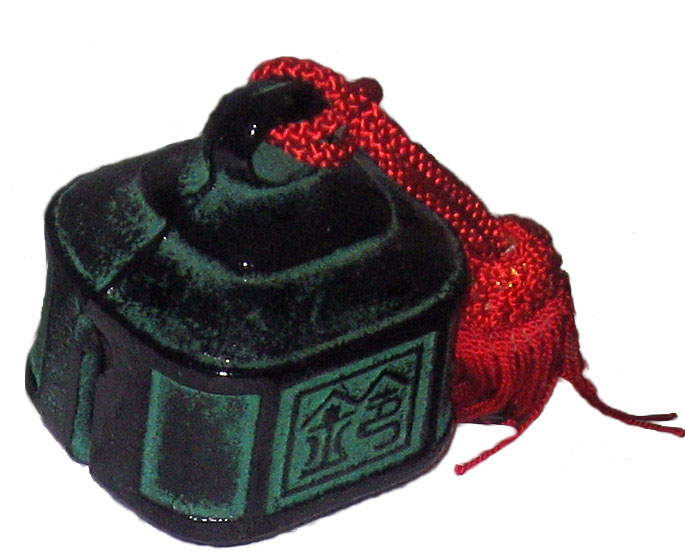Station bell on:
[Wikipedia]
[Google]
[Amazon]
 Under the Japanese
Under the Japanese
 Under the Japanese
Under the Japanese ritsuryō
, , is the historical law system based on the philosophies of Confucianism and Chinese Legalism in Japan. The political system in accord to Ritsuryō is called "Ritsuryō-sei" (律令制). ''Kyaku'' (格) are amendments of Ritsuryō, ''Shiki'' ...
system, were bells of red copper issued by the central government or by local provincial government offices to travelling officials or messengers known as . Functioning as a proof of identity, they allowed them to procure horses and labour at post stations. These post stations were located every 30 ri (16 kilometers) each providing between five and twenty messenger horses depending on the grade of the road
A road is a linear way for the conveyance of traffic that mostly has an improved surface for use by vehicles (motorized and non-motorized) and pedestrians. Unlike streets, the main function of roads is transportation.
There are many types of ...
.
Depending on the rank of the emissary, the bells were marked with a number of notches regulating the number of horses that could be requested. A prince of royal blood of first rank would receive ten horses. On urgent dispatches the ekishi would ride with the bells ringing in order to be able to change horses at any time of day or night without delay.
These bells were also known as post road bells (''ekiru no suzu'') or stable bells (''umaya no suzu''). The system was established in the Taihō Code
The was an administrative reorganisation enacted in 703 in Japan, at the end of the Asuka period. It was historically one of the . It was compiled at the direction of Prince Osakabe, Fujiwara no Fuhito and Awata no Mahito. Nussbaum, Louis ...
from 701 and was in use until the end of the 12th century or the end of the Heian period
The is the last division of classical Japanese history, running from 794 to 1185. It followed the Nara period, beginning when the 50th emperor, Emperor Kanmu, moved the capital of Japan to Heian-kyō (modern Kyoto). means "peace" in Japanese ...
when it fell in disuse together with the demise of the centralized state.
A set of two station bells located on Dōgo island in Okinoshima, Shimane Prefecture and known as has been designated as Important Cultural Property of Japan
An The term is often shortened into just is an item officially classified as Tangible Cultural Property by the Japanese government's Agency for Cultural Affairs ( Ministry of Education, Culture, Sports, Science and Technology) and judged to b ...
. Attached to the nomination is a six-legged Chinese style chest bestowed by Emperor Kōkaku
was the 119th Emperor of Japan, according to the traditional order of succession. Imperial Household Agency (''Kunaichō'')光格天皇 (119)/ref> Kōkaku reigned from 16 December 1780 until his abdication on 7 May 1817 in favor of his son, Empe ...
. The bells have been handed down in the Oki family whose members were associated with the and the regional administrators of Oki Province. They are currently located in the in Okinoshima. The two bells are of flat octagonal shape and made of cast copper. On one side of the trunk the character "驛" (station) is carved, and on the opposite side, the character "鈴" (bell). At the bottom of the bells three and four legs are attached respectively. They weigh in at and respectively. Before World War II
World War II or the Second World War, often abbreviated as WWII or WW2, was a world war that lasted from 1939 to 1945. It involved the vast majority of the world's countries—including all of the great powers—forming two opposing ...
, the bells had been designated as National Treasure of Japan
Some of the National Treasures of Japan
A is the most precious of Japan's Tangible Cultural Properties, as determined and designated by the Agency for Cultural Affairs (a special body of the Ministry of Education, Culture, Sports, Scien ...
on April 30, 1935, but lost this status in the reorganisation of cultural property protection after the war when all previously designated National Treasures were demoted to Important Cultural Properties in 1950.
See also
*Gokishichidō
was the name for ancient administrative units organized in Japan during the Asuka period (AD 538–710), as part of a legal and governmental system borrowed from the Chinese. Though these units did not survive as administrative structures beyon ...
*Hikyaku
were couriers in Japan who carried letters, documents, bills of exchange, and packages, using a system of relay stations under the bakufu military governments, beginning in the Kamakura period (1185–1333), gradually yielding to more modern syste ...
(Couriers under bakufu
, officially , was the title of the military dictators of Japan during most of the period spanning from 1185 to 1868. Nominally appointed by the Emperor, shoguns were usually the de facto rulers of the country, though during part of the Kamakura ...
governments who replaced the ''ekishi''.)
References
{{reflist Cultural history of Japan Bells (percussion)